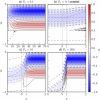The Relationship Between U.S. East Coast Sea Level and the Atlantic Meridional Overturning Circulation: A Review
- PMID: 31763114
- PMCID: PMC6853260
- DOI: 10.1029/2019JC015152
The Relationship Between U.S. East Coast Sea Level and the Atlantic Meridional Overturning Circulation: A Review
Abstract
Scientific and societal interest in the relationship between the Atlantic Meridional Overturning Circulation (AMOC) and U.S. East Coast sea level has intensified over the past decade, largely due to (1) projected, and potentially ongoing, enhancement of sea level rise associated with AMOC weakening and (2) the potential for observations of U.S. East Coast sea level to inform reconstructions of North Atlantic circulation and climate. These implications have inspired a wealth of model- and observation-based analyses. Here, we review this research, finding consistent support in numerical models for an antiphase relationship between AMOC strength and dynamic sea level. However, simulations exhibit substantial along-coast and intermodel differences in the amplitude of AMOC-associated dynamic sea level variability. Observational analyses focusing on shorter (generally less than decadal) timescales show robust relationships between some components of the North Atlantic large-scale circulation and coastal sea level variability, but the causal relationships between different observational metrics, AMOC, and sea level are often unclear. We highlight the importance of existing and future research seeking to understand relationships between AMOC and its component currents, the role of ageostrophic processes near the coast, and the interplay of local and remote forcing. Such research will help reconcile the results of different numerical simulations with each other and with observations, inform the physical origins of covariability, and reveal the sensitivity of scaling relationships to forcing, timescale, and model representation. This information will, in turn, provide a more complete characterization of uncertainty in relevant relationships, leading to more robust reconstructions and projections.
Keywords: AMOC; United States; climate model; coastal; review; sea level.
©2019. The Authors.
Figures








References
-
- Andres, M. , Gawarkiewicz, G. G. , & Toole, J. M. (2013). Interannual sea level variability in the western North Atlantic: Regional forcing and remote response. Geophysical Research Letters, 40, 5915–5919. 10.1002/2013GL058013 - DOI
-
- Bakker, P. , Schmittner, A. , Lenaerts, J. T. M. , Abe‐Ouchi, A. , Bi, D. , van den Broeke, M. R. , Chan, W. L. , Hu, A. , Beadling, R. L. , Marsland, S. J. , Mernild, S. H. , Saenko, O. A. , Swingedouw, D. , Sullivan, A. , & Yin, J. (2016). Fate of the Atlantic Meridional Overturning Circulation: Strong decline under continued warming and Greenland melting. Geophysical Research Letters, 43, 12,252–12,260. 10.1002/2016GL070457 - DOI
-
- Beadling, R. L. , Russell, J. L. , Stouffer, R. J. , & Goodman, P. J. (2018). Evaluation of subtropical North Atlantic Ocean circulation in CMIP5 models against the observational array at 26.5°N and its changes under continued warming. Journal of Climate. 10.1175/JCLI-D-17-0845.1 - DOI
-
- Becker, J. M. , & Salmon, R. (1997). Eddy formation on a continental slope. Journal of Marine Research, 55(2), 181–200. 10.1357/0022240973224418 - DOI
Publication types
LinkOut - more resources
Full Text Sources
Miscellaneous
